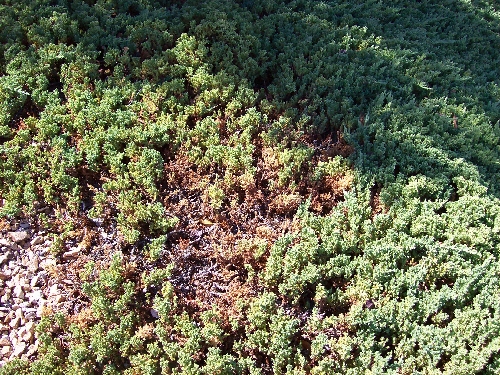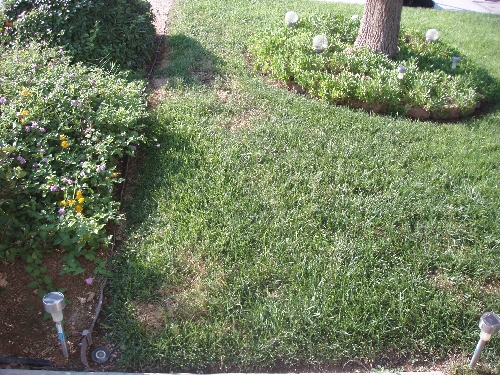Multiple applications needed to kill weed
Q: Can you identify and tell us how to kill forever a noxious weed that is single stem, upright and with red thorns every few inches. I hope the picture I sent is good enough. The roots are woody and thick to 1 inch in diameter. The roots run across and under my son's entire lawn and are fairly deep. Suckers keep coming up. I would love to kill it forever without digging up the whole lawn.
A: I couldn't tell from the picture. The description doesn't sound familiar, but it sounds like a woody plant that suckers from the roots. I am assuming they are coming from a woody plant close by, a neighbor's yard perhaps.
Any lawn weed killer that has dicamba or Banvel in the ingredients will work. This can be applied directly to the lawn without hurting the grass, but it will damage or kill woody plants and weeds that are not grasses. This will require multiple applications to keep killing new sprouts as they appear.
You will see more suckers as you use this product and it may seem like it stimulated their growth, but it has not. It has caused them to sucker more below ground due to the death of the existing suckers above ground.
Repeat applications will exhaust the reserve of woody growth under the lawn until they finally stop coming up. But you must stay on top of them with this weed killer for at least one season.
Q: Please advise and diagnose how to resolve a problem I have with my juniper bushes. I hope my pictures help.
A: From your pictures the juniper appears to be one of the very low-growing carpet junipers; I'm not sure which one it is but perhaps it could be green carpet juniper. These carpet junipers can be confusing and one of several species. It is important to determine which juniper it is as some junipers are more heat tolerant than others.
J. horizontalis has among its cultivars probably one of the better heat-tolerant rug-type junipers. Regardless, junipers will do better in this climate if they are not put into extremely hot environments and surrounded by rock. They usually can handle some of the poorer soils that can develop in rock landscapes at least for a few years, if not more.
Probably the biggest problems will include not enough water or not watering frequently enough, salt and spider mite infestations. Watering too frequently (daily) can cause root rot and death of the plant.
Make sure there is at least one day between deep waterings during the heat of the summer. One plant will probably require around 5-10 gallons per watering. You can determine this by checking your drip emitters for the gallonage per hour and adjusting this amount through the number of emitters per plants multiplied by the fraction of the hour that it remains on during one irrigation.
Spider mites are a problem on junipers. They are not insects but are more closely related to spiders. They are very small and not seen easily with the naked eye. Their feeding results in speckling or yellow spots on needles. Some needles may turn brown and drop off.
With heavy infestations, fine webbing may be seen on the plant. If not controlled, spider mites can kill junipers. Most spider mites increase in numbers during hot, dry weather.
Naturally occurring enemies of mites will usually suppress mite populations. Since insecticide use kills these enemies as well as mites, insecticides should be avoided unless absolutely necessary. Miticides, labeled specifically for mite control, are less harmful to these natural enemies. Mites can be removed with a strong spray of soap and water, if applied on a regular basis.
To determine how many mites are present, hold a white sheet of paper under a branch and slap it on the paper. The mites knocked off on to the paper will be seen crawling around as tiny spots the size of a period. If dozens of mites are seen crawling on the paper, it is time to do something.
Pesticides labeled for homeowner use against spider mites include insecticidal soaps like Safer Insecticidal Soap or Ortho's Systemic Insect Killer. As with any pesticide, read and follow all label directions and precautions before using.
Q: These critters have devastated one of my grape vines. Here is a picture. Thousands of little sucking holes ruin the leaves and thus the vine. They are about one-quarter-inch long and may also fly. What are they and how can I defend against them for next year?
A: The picture was a bit blurry but appears to be grape leafhopper. However the description of the damage sounds like grape flea beetle. If they are leafhoppers, the insects are small, maybe one-quarter inch long. In their mature stage, they can jump short distances. There literally can be thousands of them on a grapevine, with many of them jumping when you walk by the vine and landing on your face and clothes. It's very irritating.
They can be curtailed by applying an organic, biological control of Spinosad in early May and again in mid-May when the nymphs or immature forms are present. It will control the nymphs but does not do much to the adults. If you get it applied early enough, this will reduce the population when the adults mature. Make sure you spray the underside of the leaves as well as the tops.
If these are grape flea beetles, then they should be gone in about two weeks and a pesticide is usually not necessary as the damage is not long term.
Q: I have some brown patches in the grass in my yard. The sprinklers are working fine and the recent rains haven't made any difference. This area was nice and green until about three weeks ago. I'm hoping you may have some idea what is causing this and what I might do to resolve the problem. The rest of the yard is fine.
A: From the pictures you sent, it appears that your lawn has summer patch disease. This disease used to be called Fusarium patch in the old days. Some management techniques that you can try include mowing the lawn a bit shorter during the heat of the summer.
If you fertilize your lawn during the summer, make sure you use half the amount recommended on the bag or less. Fertilize in the early morning hours only and make sure it is watered immediately after the application. Foliar applications would be even better.
Avoid watering the lawn anytime between late afternoon and early evening and about 2 a.m. You can water any time after 2 a.m., but try to get it done before sunrise.
Otherwise you will need to apply fungicides to your lawn that have been approved for controlling summer patch or Fusarium diseases. You can find this out by reading the label.
Fungicides are best at preventing diseases from spreading, not curing them after the disease has ravaged the lawn. Mark your calendar for next year and apply a fungicide anytime you see summer monsoons predicted.
Bob Morris is a horticulture expert living in Las Vegas. Visit his blog at xtremehorticulture.blogspot.com.


















